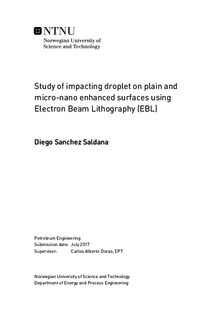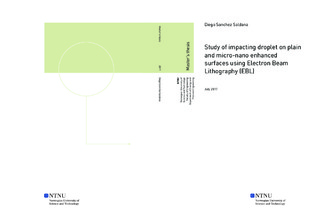| dc.description.abstract | Compact systems with high power densities are being vastly designed and fabricated in the present. These include electronic devices, CPU chips, telecom equipment, micro-chemical reactors, micro-fuel cell combusts, power semiconductor lasers and radar amplifiers. Yet, the most important problem regarding these devices lies in effective dissipation of the tremendous heat that they produce reaching beyond air cooling limits, therefore liquid cooling will become necessary. Liquid cooling has a limitation in its use, it is called Leidenfrost phenomenon in which, a vapour film is formed in between the liquid and the solid hot surface at a certain temperature and hences a spontaneous reduction in heat transfer. Nanotechnology is allowing for the development of surfaces with special properties that improve the limitation of heat transfer for instance Si nanowires.
The main objective in this work is to identify and fabricate nanostructures for improving the Leidenfrost phenomenon, enhancing the heat transfer performance, and the design and fabrication of an experimental setup for the visualization of Leidenfrost phenomenon identifying the maximum heat flux and the Leidenfrost point. In this project techniques for fabricating the selected structures have been carried out and the structures have been characterized by available equipment at the NTNU Nanolab. Furthermore, design and fabrication of a test section for studying impacting droplets over a micro-nano structure surface has been completed.
Important results uncovered in this work are the following. Description of the facility setup. Plain polished silicon reference Leidenfrost curves and Weber map with water and FC-72 have been defined for a better understanding of the Leidenfrost phenomenon. This, ultimately, allowed for an optimization in the processes of heat transfer. Anomalous wetting characteristics and improvements of limitation in the Leidenfrost phenomenon have been identified for samples with nanostructures compared with plain polished silicon. | |

